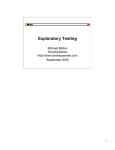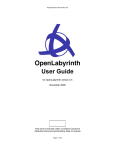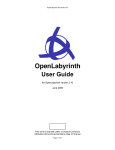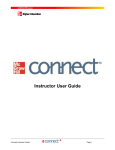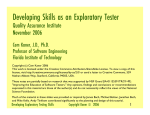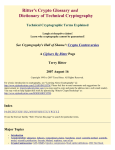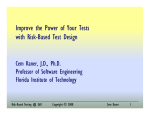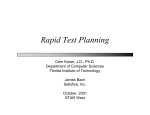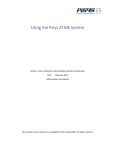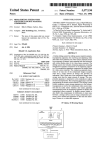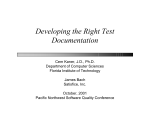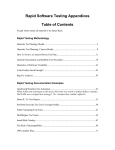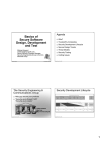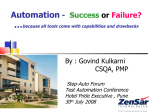Download Rapid Software Testing
Transcript
Rapid Software Testing™ Copyright © 1995-2015, Satisfice, Inc. Rapid Software Testing™ Copyright © 1995-2015, Satisfice, Inc. Although the value of the class is greater because of the people who helped us, the sole responsibility for the content of this class belongs to the authors, James Bach and Michael Bolton. This class is essentially a long editorial opinion about testing. We have no authority to say what is right. There are no authorities in our field. We don’t peddle best practices. We don’t believe in them. What we will do is share our experiences and challenge your mind. We hope you will challenge us back. You’ll find the class more rewarding, we think, if you assume that our purpose is to make you stronger, smarter and more confident as a tester. Our purpose is NOT to have you listen to what the instructor says and believe it, but to listen and then think for yourself. All good testers think for themselves. In a way, that’s what testing is about. We look at things differently than everyone else so that we can find problems no one else will find. Rapid Software Testing™ Copyright © 1995-2015, Satisfice, Inc. If any of these assumptions don’t fit, this class might not be for you. We don’t make any assumptions about how experienced you are. The class can work well for novices or experts. It’s the desire to be very good at software testing that compels you to want to take a class. Most of the people in the world who work in software testing have never taken a testing class, read a testing book, attended a testing conference, participated in a test user group. They still get to keep their jobs, and they might even be okay at testing. A class like this becomes important when you want to be confident and great at software testing. As a supplement to this course, consider the Black Box Software Testing course available through http://www.testingeducation.org. This course, developed by Cem Kaner and James Bach, is set up for selfstudy. It’s composed of more than 40 hours of video lectures, and includes detailed course notes, quizzes, self-tests, supplementary reading materials, and links to more. The Association for Software Testing (http://associationforsoftwaretesting.org) offers instructor-led versions of the course to its members. Rapid Software Testing™ Copyright © 1995-2015, Satisfice, Inc. Rapid Software Testing™ Copyright © 1995-2015, Satisfice, Inc. Rapid testing is a mind set–a particular way of looking at the world; and a skill set—a particular set of things that we practice and get better at. We’re advocates of the context-driven approach to software testing. We’ve applied these approaches in financial institutions, in court cases, in testing of medical devices, in commercial shrink-wrapped software, to games… The methodology is designed to adapt to any kind of testing context. Rapid testing involves considerations of skill, personal integrity, improved focus on the underlying need for testing tasks, improved appreciation for the stakeholders of testing tasks, and knowledge of the possible techniques and tools that could be brought to bear to improve efficiency. Rapid Software Testing™ Copyright © 1995-2015, Satisfice, Inc. A methodology is a “system of methods.” It’s a “how-to.” But in testing a lot of the how-to is tacit (unspoken). To learn to test you must experience testing and struggle to solve testing problems. The explicit (written, spoken, or pictured) part of methodology sits on top of that. Rapid Software Testing™ Copyright © 1995-2015, Satisfice, Inc. These are the premises of the Rapid Software Testing methodology. Everything in the methodology derives in some way from this foundation. These premises derive from our experience, study, and discussions over a period of decades. They have been shaped by the influence of two thinkers above all: Cem Kaner and Jerry Weinberg, both of whom have worked as programmers, managers, social scientists, authors, teachers, and of course, testers. . Rapid Software Testing™ Copyright © 1995-2015, Satisfice, Inc. Rapid Software Testing™ Copyright © 1995-2015, Satisfice, Inc. Rapid Software Testing™ Copyright © 1995-2015, Satisfice, Inc. Without scrutiny, this would be easy to do. You could test badly, but no one would ever know or care. What makes testing hard is that someone, perhaps your employer, perhaps the users, or perhaps you yourself, will be judging your work. Maybe this scrutiny will be indirect, such as someone unhappy with the product and cursing your company for building it so poorly. Or perhaps it will be the most intimate form of scrutiny– which is your feeling of pride or disappointment in your own work. If you want your testing to pass muster, you need to work at it. Rapid Software Testing™ Copyright © 1995-2015, Satisfice, Inc. You will get some practice in thinking like an expert tester. That will mean some success and some failures. For the successes, we want you to feel good—strong and powerful; that’s a feeling that an expert tester gets. Alas, from time to time, expert testers also get the opportunity to feel embarrassed by failure. There are many traps in the exercises. We want to give you the experience of being trapped, of recognizing the traps, and of working your way out of them. This class is intended to provide you with a safe place to do that, so you can recognize similar situations and respond appropriately when you’re on the job. We also expect you to challenge our expertise. That’s part of developing your own expertise, but it’s also fundamental to our development. Any “expert” can be wrong, and “expert advice” is always wrong in some context, so we don’t get upset if you argue. On the contrary; we’re delighted if you argue. Challenging our statements shows us that you’re thinking about how things might work—or not—in your own environment. The conversation is often very enlightening. Rapid Software Testing™ Copyright © 1995-2015, Satisfice, Inc. Rapid Software Testing™ Copyright © 1995-2015, Satisfice, Inc. Rapid Software Testing™ Copyright © 1995-2015, Satisfice, Inc. Rapid Software Testing™ Copyright © 1995-2015, Satisfice, Inc. The first question about quality is always “whose opinions matter?” If someone who doesn’t matter thinks your product is terrible, you don’t necessarily change anything. So, an important bug is something about a product that really bugs someone important. One implication of this is that, if we see something that we think is a bug and we’re overruled, we don’t matter. That’s a fact: testers don’t matter. That is to say, our standards are not the standards to which the product must adhere; we don’t get to make decisions about quality. This can be hard for some testers to accept, but it’s the truth. We provide information to managers; they get to make the hard decisions. They get the big bucks, and we get to sleep at night. Rapid Software Testing™ Copyright © 1995-2015, Satisfice, Inc. Rapid Software Testing™ Copyright © 1995-2015, Satisfice, Inc. Rapid Software Testing™ Copyright © 1995-2015, Satisfice, Inc. 18 Rapid Software Testing™ Copyright © 1995-2015, Satisfice, Inc. Freedom: The ability to do things that might hurt people (including yourself). Wisdom: Knowing how not to hurt people (including yourself). Responsibility: Choosing not hurt people (including yourself). Rapid Software Testing™ Copyright © 1995-2015, Satisfice, Inc. Rapid Software Testing™ Copyright © 1995-2015, Satisfice, Inc. - 21 - Rapid Software Testing™ Copyright © 1995-2015, Satisfice, Inc. Rapid Software Testing™ Copyright © 1995-2015, Satisfice, Inc. Rapid Software Testing™ Copyright © 1995-2015, Satisfice, Inc. Rapid Software Testing™ Copyright © 1995-2015, Satisfice, Inc. Rapid Software Testing™ Copyright © 1995-2015, Satisfice, Inc. Rapid Software Testing™ Copyright © 1995-2015, Satisfice, Inc. Rapid Software Testing™ Copyright © 1995-2015, Satisfice, Inc. Rapid Software Testing™ Copyright © 1995-2015, Satisfice, Inc. Rapid Software Testing™ Copyright © 1995-2015, Satisfice, Inc. Rapid Software Testing™ Copyright © 1995-2015, Satisfice, Inc. Rapid Software Testing™ Copyright © 1995-2015, Satisfice, Inc. Rapid Software Testing™ Copyright © 1995-2015, Satisfice, Inc. Rapid Software Testing™ Copyright © 1995-2015, Satisfice, Inc. Rapid Software Testing™ Copyright © 1995-2015, Satisfice, Inc. Rapid Software Testing™ Copyright © 1995-2015, Satisfice, Inc. Rapid Software Testing™ Copyright © 1995-2015, Satisfice, Inc. Rapid Software Testing™ Copyright © 1995-2015, Satisfice, Inc. By “model”, we mean that we must build a representation in our minds of what the product must do. If our model is incorrect or limited, then we automatically will not test what should be tested. The first four items on the list are usually called “test design”. The latter five items are usually called “test execution”. Rapid Software Testing™ Copyright © 1995-2015, Satisfice, Inc. Rapid Software Testing™ Copyright © 1995-2015, Satisfice, Inc. Rapid Software Testing™ Copyright © 1995-2015, Satisfice, Inc. Rapid Software Testing™ Copyright © 1995-2015, Satisfice, Inc. Rapid Software Testing™ Copyright © 1995-2015, Satisfice, Inc. Rapid Software Testing™ Copyright © 1995-2015, Satisfice, Inc. Rapid Software Testing™ Copyright © 1995-2015, Satisfice, Inc. - 45 - Rapid Software Testing™ Copyright © 1995-2015, Satisfice, Inc. Rapid Software Testing™ Copyright © 1995-2015, Satisfice, Inc. Rapid Software Testing™ Copyright © 1995-2015, Satisfice, Inc. Rapid Software Testing™ Copyright © 1995-2015, Satisfice, Inc. Rapid Software Testing™ Copyright © 1995-2015, Satisfice, Inc. Rapid Software Testing™ Copyright © 1995-2015, Satisfice, Inc. Rapid Software Testing™ Copyright © 1995-2015, Satisfice, Inc. Our colleague, Jeremy Kominar, is an expert amateur magician. We asked him to provide us with some remarks on the links between software testing and magic. Here’s an edited version of what he had to say--we can’t quote him exactly, because he asked us not to give away his secrets! •Learning to perform magic causes the magician to be aware of not only his own perspective, but also (and more importantly) others’ perception of the trick. This becomes invaluable for testers because it helps us to recognize that the interests and perspectives of many stakeholders must be considered when testing software. The trick may “look good” or “work” from your angle, but there are always other angles to cover. •When learning to perform magic tricks, you generally want to simplify things--minimize the number of moves and figure out how you can reach the same end result without as many steps to get there. In a testing context this idea can be used for creating different usage scenarios—taking multiple paths and variables to attain the same goal. (We might want to minimize the number of steps, but we might also want to vary the paths to shake out more bugs.) •Learning to perform magic and learning to figure out magic tricks require us to develop observational skills, and to recognize things that deceive us. Most non-magicians fail to consider possibilities that come easily to magicians; devices, coins, or cards can be gimmicked. Non-magicians only think about normal cards. You need to think outside of the box to be a magician or to figure out how the magician does his work. This kind of reasoning and deduction are key assets to being a tester. There isn’t really such a thing as magic but there clearly is such a thing as deception. As the magician becomes more experienced and more wise to the practice, he should be able to reverse-engineer tricks by using patterns that he already knows about magic. Once you’ve seen one kind of trick, similar tricks aren’t so mysterious because you have heuristics that you can use to recognize how it’s done. Rapid Software Testing™ Copyright © 1995-2015, Satisfice, Inc. Rapid Software Testing™ Copyright © 1995-2015, Satisfice, Inc. Rapid Software Testing™ Copyright © 1995-2015, Satisfice, Inc. Rapid Software Testing™ Copyright © 1995-2015, Satisfice, Inc. Jerry Weinberg has suggested that “it works” may mean “We haven't tried very hard to make it fail, and we haven't been running it very long or under very diverse conditions, but so far we haven't seen any failures, though we haven't been looking too closely, either.” In this pessimistic view, you have to be on guard for people who say it works without checking even once to see if it could work. Rapid Software Testing™ Copyright © 1995-2015, Satisfice, Inc. Mipping is a way of bug reporting when you aren’t confident in the value of a bug. It’s an acronym that stands for “mention in passing.” To MIP a bug is to report it in an informal and inexpensive way, such as through email or chat. That way, you don’t get in trouble for not reporting it, and you don’t get in trouble for overreporting it. Black flagging is the opposite of that. When you black flag a bug you put a lot of energy into the report. You may write a white paper about it, and call a meeting to discuss it. This is necessary in cases where a simple bug report won’t capture the extent of the risk, or when you feel that fixing the bug will not adequately deal with the risks related to that bug (perhaps because you feel that the product may need a comprehensive redesign. Usually we black flag a bug when it seems to represent a cluster of potentially related problems that collectively pose a large risk. Rapid Software Testing™ Copyright © 1995-2015, Satisfice, Inc. Rapid Software Testing™ Copyright © 1995-2015, Satisfice, Inc. Rapid Software Testing™ Copyright © 1995-2015, Satisfice, Inc. In exploratory testing, the first oracle to trigger is usually a personal feeling. Then you move from that to something more explicit and defensible. We need to move in that direction because testing is social. We probably can’t just go with our gut and leave it at that, because we have to convince other people that it’s really a bug. Rapid Software Testing™ Copyright © 1995-2015, Satisfice, Inc. Rapid Software Testing™ Copyright © 1995-2015, Satisfice, Inc. Types of “Easy Input” oracles: Fixed Markers. Use distinctive fixed input patterns that are easy to spot in the output. Statistical Markers. Use populations of data that have distinguishable statistical properties. Self-Referential Data. Use data that embeds metadata about itself. (e.g. counterstrings) Easy Input Regions. For specific inputs, the correct output may be easy to calculate. Outrageous Values. For some inputs, we expect error handling. Idempotent Input. Try a case where the output will be the same as the input. Match. Do the “same thing” twice and look for a match. Progressive Mismatch. Do progressively differing things over time and account for each difference. (codebreaking technique) Fixed Markers. Use distinctive fixed input patterns that are easy to spot in the output. Some programmers use the hex values 0xDEADBEEF as a flag to indicate uninitialized data. Statistical Markers. Use populations of data that have distinguishable statistical properties. If you create input that has a specific statistical property, then you may be able to detect missing or corrupted data by examining the statistical properties of the output. Self-referential data. Use data that embeds data about itself. (e.g. counterstrings). Counterstrings are strings that identify their lengths. *3*5*7*9*12*15* is an example of a counterstring. (Satisfice’s PERLCLIP tool creates counterstrings of arbitrary lengths.) Another example is using JAMES_FIRSTNAME and BACH_LASTNAME as sample data in the first name and last name fields of a database. Easy Input Regions. For specific inputs, the correct output may be easy to calculate. A number times one is always itself; a number plus zero is always itself; a multiple of ten always ends in 0, and so on. Outrageous values. For some inputs, we expect error handling. Examples include letters in fields that expect Rapid Software Testing™ Copyright © 1995-2015, Satisfice, Inc. only numbers, extremely long strings in fields that expect short ones, huge numbers where modest ones are expected, or zero or null values where some positive value is required. Each example should trigger some kind of error handling. Idempotent input. Try a case where the output will be the same as the input. Take some data and process it in some way, such that the output from the first run can be used as input for subsequent runs but shouldn’t go through additional changes. Examples include spell-checking (after all the corrections have been accepted for the first run, no further changes should be suggested) or code formatters (after the code has been formatted once, the same code should pass through the process unchanged). Match. Do the “same thing” twice and look for a match. Given the same input data and the same function on that data, we would typically expect the output to be the same. This approach is sometimes used to check various kinds of encoding or checksums. Progressive mismatch. Do progressively differing things over time and account for each difference. Vary the input in some limited or controlled way. This is an exploratory approach, sometimes used as a code-breaking technique. Rapid Software Testing™ Copyright © 1995-2015, Satisfice, Inc. Development. How well can we create, test, and modify it? Supportability: How economical will it be to provide support to users of the product? Testability: How effectively can the product be tested? Maintainability: How economical is it to build, fix or enhance the product? Portability: How economical will it be to port or reuse the technology elsewhere? Localizability: How economical will it be to adapt the product for other places? Rapid Software Testing™ Copyright © 1995-2015, Satisfice, Inc. Rapid Software Testing™ Copyright © 1995-2015, Satisfice, Inc. Rapid Software Testing™ Copyright © 1995-2015, Satisfice, Inc. Rapid Software Testing™ Copyright © 1995-2015, Satisfice, Inc. Rapid Software Testing™ Copyright © 1995-2015, Satisfice, Inc. Rapid Software Testing™ Copyright © 1995-2015, Satisfice, Inc. Rapid Software Testing™ Copyright © 1995-2015, Satisfice, Inc. Rapid Software Testing™ Copyright © 1995-2015, Satisfice, Inc. Rapid Software Testing™ Copyright © 1995-2015, Satisfice, Inc. Rapid Software Testing™ Copyright © 1995-2015, Satisfice, Inc. Key ideas about heuristics: •A heuristic is not an edict. Heuristics require guidance and control of skilled practitioner. •Heuristics are context-dependent. •Heuristics may be useful even when they contradict each other– especially when they do! •Heuristics can substitute for complete and rigorous analysis. Types of heuristics: •Guideword Heuristics: Words or labels that help you access the full spectrum of your knowledge and experience as you analyze something. •Trigger Heuristics: Ideas associated with an event or condition that help you recognize when it may be time to take an action or think a particular way. Like an alarm clock for your mind. •Subtitle Heuristics: Help you reframe an idea so you can see alternatives and bring out assumptions during a conversation. •Heuristic Model: A representation of an idea, object, or system that helps you explore, understand, or control it. •Heuristic Procedure or Rule: A plan of action that may help solve a class of problems. Rapid Software Testing™ Copyright © 1995-2015, Satisfice, Inc. •Cognitive Heuristics: Heuristics built into your mind by virtue of how human brains work. These show themselves as systematic biases in our senses (optical illusions) and decision-making. Rapid Software Testing™ Copyright © 1995-2015, Satisfice, Inc. Everyday examples of heuristics: •It’s dangerous to drink and drive. •A bird in hand is worth two in the bush. •Nothing ventured, nothing gained. •Sometimes people stash their passwords near their computers. Try looking there. •Stores are open later during the Holidays. •If your computer is behaving strangely, try rebooting. If it’s very strange, reinstall Windows. •If it’s a genuinely important task, your boss will follow-up, otherwise, you can ignore it. Rapid Software Testing™ Copyright © 1995-2015, Satisfice, Inc. Rapid Software Testing™ Copyright © 1995-2015, Satisfice, Inc. Rapid Software Testing™ Copyright © 1995-2015, Satisfice, Inc. Rapid Software Testing™ Copyright © 1995-2015, Satisfice, Inc. Rapid Software Testing™ Copyright © 1995-2015, Satisfice, Inc. Rapid Software Testing™ Copyright © 1995-2015, Satisfice, Inc. “State Conservation” means that you minimize disturbances to the product state, maintaining it as much as possible while using the product. Rapid Software Testing™ Copyright © 1995-2015, Satisfice, Inc. Rapid Software Testing™ Copyright © 1995-2015, Satisfice, Inc. Rapid Software Testing™ Copyright © 1995-2015, Satisfice, Inc. Rapid Software Testing™ Copyright © 1995-2015, Satisfice, Inc. Rapid Software Testing™ Copyright © 1995-2015, Satisfice, Inc. Rapid Software Testing™ Copyright © 1995-2015, Satisfice, Inc. Rapid Software Testing™ Copyright © 1995-2015, Satisfice, Inc. Rapid Software Testing™ Copyright © 1995-2015, Satisfice, Inc. Some people prefer a more restrictive definition of procedure. Cem Kaner considers a sequential set of steps to be an important aspect of procedure. He would prefer that we use the word “test implementation” instead of procedure, in this section. However, in the Rapid Testing methodology, we usually opt for the most inclusive definitions that still express the key ideas, since that makes the conversation easier. In our view, the word procedure as it is commonly used is not limited only to sequential instruction sets. As always, it’s up to you what words you use. Rapid Software Testing™ Copyright © 1995-2015, Satisfice, Inc. Rapid Software Testing™ Copyright © 1995-2015, Satisfice, Inc. Rapid Software Testing™ Copyright © 1995-2015, Satisfice, Inc. Rapid Software Testing™ Copyright © 1995-2015, Satisfice, Inc. Rapid Software Testing™ Copyright © 1995-2015, Satisfice, Inc. Rapid Software Testing™ Copyright © 1995-2015, Satisfice, Inc. Rapid Software Testing™ Copyright © 1995-2015, Satisfice, Inc. Rapid Software Testing™ Copyright © 1995-2015, Satisfice, Inc. Rapid Software Testing™ Copyright © 1995-2015, Satisfice, Inc. We’ll come back to these later. For now, note that we’re more likely to catch different bugs with different nets; a diverse set of test techniques will find a diverse set of bugs. Rapid Software Testing™ Copyright © 1995-2015, Satisfice, Inc. Rapid Software Testing™ Copyright © 1995-2015, Satisfice, Inc. Rapid Software Testing™ Copyright © 1995-2015, Satisfice, Inc. Testing is itself a form of risk analysis: risk-based testing begins with a rumor of risk and transforms that into information. Even if testing reveals a problem that cannot be reproduced, you have learned something about risk. Exploratory testing is a popular and powerful approach to analyzing risk. Scripted testing is better suited for monitoring known risk. Rapid Software Testing™ Copyright © 1995-2015, Satisfice, Inc. Rapid Software Testing™ Copyright © 1995-2015, Satisfice, Inc. Happy Path: Use the product in the most simple, expected, straightforward way, just as the most optimistic programmer might imagine users to behave. Perform a task, from start to finish, that an end-user might be expected to do. Look for anything that might confuse, delay, or irritate a reasonable person. Documentation Tour: Look in the online help or user manual and find some instructions about how to perform some interesting activity. Do those actions. Improvise from them. If your product has a tutorial, follow it. You may expose a problem in the product or in the documentation; either way, you’ve found something useful. Even if you don’t expose a problem, you’ll still be learning about the product. Sample Data Tour: Employ any sample data you can, and all that you can—the more complex or extreme the better. Use zeroes where large numbers are expected; use negative numbers where positive numbers are expected; use huge numbers where modestly -sized ones are expected; and use letters in every place that’s supposed to handle numbers. Change the units or formats in which data can be entered. Challenge the assumption that the programmers have thought to reject inappropriate data. Variables Tour: Tour a product looking for anything that is variable and vary it. Vary it as far as possible, in every dimension possible. Identifying and exploring variations is part of the basic structure of my testing when I first encounter a product. Complexity Tour: Tour a product looking for the most complex features and using challenging data sets. Look for nooks and crowds where bugs ca n hide. File Tour: Have a look at the folder where the program's .EXE file is found. Check out the directory structure, including subs. Loo k for READMEs, help files, log files, installation scripts, .cfg, .ini, .rc files. Look at the names of .DLLs, and extrapolate on the functions that they might contain or the ways in which their absence might undermine the application. Menus and Windows Tour: Tour a product looking for all the menus (main and context menus), menu items, windows, toolbars, icons, and other controls. Keyboard and Mouse Tour: Tour a product looking for all the things you can do with a keyboard and mouse. Run through all of the keys on the keyboard. Hit all the F-keys. Hit Enter, Tab, Escape, Backspace. Run through the alphabet in order. Combine each key with Sh ift, Ctrl, and Alt. Also, click on everything. Interruptions: Start activities and stop them in the middle. Stop them at awkward times. Perform stoppages using cancel buttons, O/S level interrupts (ctrl-alt-delete or task manager), arrange for other programs to interrupt (such as screensavers or virus checkers). Also try suspending an activity and returning later. Undermining: Start using a function when the system is in an appropriate state, then change the state part way through (for instance, dele te a file while it is being edited, eject a disk, pull net cables or power cords) to an inappropriate state. This is similar to interru ption, except you are expecting the function to interrupt itself by detecting that it no longer can proceed safely. Adjustments: Set some parameter to a certain value, then, at any later time, reset that value to something else without resetting or recre ating the containing document or data structure. Dog Piling: Get more processes going at once; more states existing concurrently. Nested dialog boxes and non-modal dialogs provide opportunities to do this. Continuous Use: While testing, do not reset the system. Leave windows and files open. Let disk and memory usage mount. You're hoping that the system ties itself in knots over time. Feature Interactions: Discover where individual functions interact or share data. Look for any interdependencies. Tour them. Stress them. I once crashed an app by loading up all the fields in a form to their maximums and then traversing to the report generator. Look fo r places where the program repeats itself or allows you to do the same thing in different places. Click for Help: At some point, some users are going to try to bring up the context-sensitive help feature during some operation or activity. Does Rapid Software Testing™ Copyright © 1995-2015, Satisfice, Inc. the product’s help file explain things in a useful way, or does it offend the user’s intelligence by simply restating what’s already on the screen? Is help even available at all? Rapid Software Testing™ Copyright © 1995-2015, Satisfice, Inc. Input Constraint Attack: Discover sources of input and attempt to violate constraints on that input. For instance, use a geometrically expanding string in a field. Keep doubling its length until the product crashes. Use special characters. Inject noise of any kind into a system and see what happens. Use Satisfice’s PerlClip utility to create strings of arbitrary length and content; use PerlClip’s counterstring feature to create a string that tells you its own length so that you can see where an application cuts off input. Click Frenzy: Ever notice how a cat or a kid can crash a system with ease? Testing is more than "banging on the keyboard", but that phrase wasn't coined for nothing. Try banging on the keyboard. Try clicking everywhere. I broke into a touchscreen system once by poking ev ery square centimeter of every screen until I found a secret button. Shoe Test: This is any test consistent with placing a shoe on the keyboard. Basically, it means using auto-repeat on the keyboard for a very cheap stress test. Look for dialog boxes so constructed that pressing a key leads to, say, another dialog box (perhaps an error mes sage) that also has a button connected to the same key that returns to the first dialog box. That way you can place a shoe (or Coke can, as I often do, but sweeping off a cowboy boot has a certain drama to it) on the keyboard and walk away. Let the test run for an hour. If there’s a resource or memory leak, this kind of test will expose it. Blink Test: Find some aspect of the product that produces huge amounts of data or does some operation very quickly. For instance, look a long log file or browse database records very quickly. Let the data go by too quickly to see in detail, but notice trends in length or look or shape of the data. Some bugs are easy to see this way that are hard to see with detailed analysis. Use Excel’s conditional formatting feature to highlight interesting distinctions between cells of data. Error Message Hangover: Make error messages happen and test hard after they are dismissed. Often developers handle errors poorly. Resource Starvation: Progressively lower memory, disk space, display resolution, and other resources until the product collapses, or gracefully (w e hope) degrades. Multiple Instances: Run a lot of instances of the app at the same time. Open the same files. Manipulate them from different windows. Crazy Configs: Modify the operating system’s configuration in non-standard or non-default ways either before or after installing the product. Turn on “high contrast” accessibility mode, or change the localization defaults. Change the letter of the system hard drive. Cons ider that the product has configuration options, too—change them or corrupt them in a way that should trigger an error message or an appropriate default b ehavior. Cheap Tools: Learn how to use InCtrl5, Filemon, Regmon, AppVerifier, Perfmon, and Process Explorer, and Task Manager (all of which are fre e). Have these tools on a thumb drive and carry it around. Also, carry a digital camera. I now carry a tiny 3 megapixel camera an d a tiny video camera. Both fit into my coat pockets. I use them to record screen shots and product behaviors. While it’s not cheap, you can usuall y find Excel on most Windows systems; use it to create test matrices, tables of test data, charts that display performance results, and so on. Us e the World-Wide Web Consortium’s HTML Validator at http://validator.w3c.org. Pay special attention to tools that hackers use; these tools can be used for good as well as for evil. Netcat, Burp Proxy, wget, and fuzzer are but a few examples. Rapid Software Testing™ Copyright © 1995-2015, Satisfice, Inc. Rapid Software Testing™ Copyright © 1995-2015, Satisfice, Inc. Rapid Software Testing™ Copyright © 1995-2015, Satisfice, Inc. Rapid Software Testing™ Copyright © 1995-2015, Satisfice, Inc. Rapid Software Testing™ Copyright © 1995-2015, Satisfice, Inc. Rapid Software Testing™ Copyright © 1995-2015, Satisfice, Inc. Rapid Software Testing™ Copyright © 1995-2015, Satisfice, Inc. Rapid Software Testing™ Copyright © 1995-2015, Satisfice, Inc. Rapid Software Testing™ Copyright © 1995-2015, Satisfice, Inc. Rapid Software Testing™ Copyright © 1995-2015, Satisfice, Inc. Detailed procedural documentation is expensive and largely unnecessary. Tutorial documentation is also usually unnecessary, but if you do it, then keep it separate from the working documents. Rapid Software Testing™ Copyright © 1995-2015, Satisfice, Inc. Rapid Software Testing™ Copyright © 1995-2015, Satisfice, Inc. Rapid Software Testing™ Copyright © 1995-2015, Satisfice, Inc. Rapid Software Testing™ Copyright © 1995-2015, Satisfice, Inc. Rapid Software Testing™ Copyright © 1995-2015, Satisfice, Inc. Rapid Software Testing™ Copyright © 1995-2015, Satisfice, Inc. Rapid Software Testing™ Copyright © 1995-2015, Satisfice, Inc. Rapid Software Testing™ Copyright © 1995-2015, Satisfice, Inc. Rapid Software Testing™ Copyright © 1995-2015, Satisfice, Inc. Rapid Software Testing™ Copyright © 1995-2015, Satisfice, Inc. Rapid Software Testing™ Copyright © 1995-2015, Satisfice, Inc. Rapid Software Testing™ Copyright © 1995-2015, Satisfice, Inc. Rapid Software Testing™ Copyright © 1995-2015, Satisfice, Inc. Rapid Software Testing™ Copyright © 1995-2015, Satisfice, Inc. Rapid Software Testing™ Copyright © 1995-2015, Satisfice, Inc. Rapid Software Testing™ Copyright © 1995-2015, Satisfice, Inc. Rapid Software Testing™ Copyright © 1995-2015, Satisfice, Inc. Rapid Software Testing™ Copyright © 1995-2015, Satisfice, Inc. Rapid Software Testing™ Copyright © 1995-2015, Satisfice, Inc. Rapid Software Testing™ Copyright © 1995-2015, Satisfice, Inc. Rapid Software Testing™ Copyright © 1995-2015, Satisfice, Inc. Rapid Software Testing™ Copyright © 1995-2015, Satisfice, Inc. Rapid Software Testing™ Copyright © 1995-2015, Satisfice, Inc. Rapid Software Testing™ Copyright © 1995-2015, Satisfice, Inc. Rapid Software Testing™ Copyright © 1995-2015, Satisfice, Inc. Rapid Software Testing™ Copyright © 1995-2015, Satisfice, Inc. Rapid Software Testing™ Copyright © 1995-2015, Satisfice, Inc. Rapid Software Testing™ Copyright © 1995-2015, Satisfice, Inc. Rapid Software Testing™ Copyright © 1995-2015, Satisfice, Inc. Rapid Software Testing™ Copyright © 1995-2015, Satisfice, Inc. Rapid Software Testing™ Copyright © 1995-2015, Satisfice, Inc. Rapid Software Testing™ Copyright © 1995-2015, Satisfice, Inc. Rapid Software Testing™ Copyright © 1995-2015, Satisfice, Inc.





















































































































































